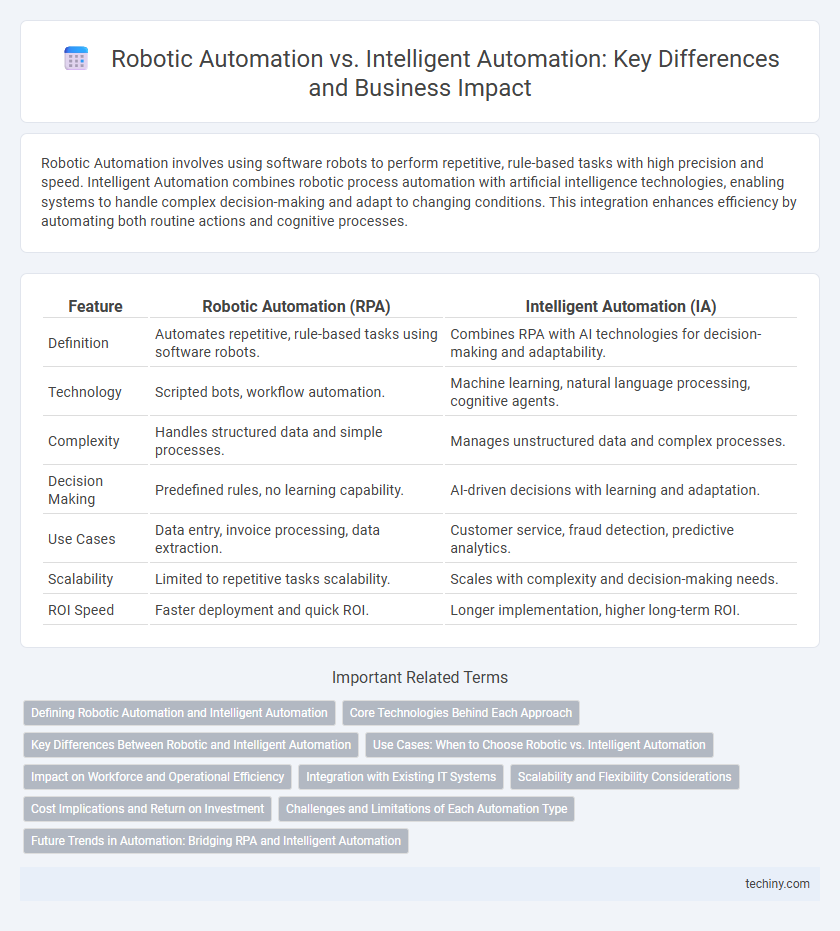Robotic Automation involves using software robots to perform repetitive, rule-based tasks with high precision and speed. Intelligent Automation combines robotic process automation with artificial intelligence technologies, enabling systems to handle complex decision-making and adapt to changing conditions. This integration enhances efficiency by automating both routine actions and cognitive processes.
Table of Comparison
| Feature | Robotic Automation (RPA) | Intelligent Automation (IA) |
|---|---|---|
| Definition | Automates repetitive, rule-based tasks using software robots. | Combines RPA with AI technologies for decision-making and adaptability. |
| Technology | Scripted bots, workflow automation. | Machine learning, natural language processing, cognitive agents. |
| Complexity | Handles structured data and simple processes. | Manages unstructured data and complex processes. |
| Decision Making | Predefined rules, no learning capability. | AI-driven decisions with learning and adaptation. |
| Use Cases | Data entry, invoice processing, data extraction. | Customer service, fraud detection, predictive analytics. |
| Scalability | Limited to repetitive tasks scalability. | Scales with complexity and decision-making needs. |
| ROI Speed | Faster deployment and quick ROI. | Longer implementation, higher long-term ROI. |
Defining Robotic Automation and Intelligent Automation
Robotic Automation refers to the use of software robots or "bots" to perform repetitive, rule-based tasks typically executed by humans, such as data entry or transaction processing. Intelligent Automation combines Robotic Process Automation (RPA) with Artificial Intelligence (AI) technologies like machine learning, natural language processing, and computer vision to handle complex, unstructured tasks requiring decision-making and adaptation. While Robotic Automation excels in automating routine workflows, Intelligent Automation enhances efficiency through cognitive capabilities, enabling dynamic responses to varying inputs and scenarios.
Core Technologies Behind Each Approach
Robotic Automation primarily relies on rule-based software bots designed to execute repetitive tasks using technologies like robotic process automation (RPA) and screen scraping. Intelligent Automation integrates advanced technologies such as artificial intelligence (AI), machine learning (ML), natural language processing (NLP), and computer vision to enable decision-making and adapt to complex processes. Core technologies in Intelligent Automation enhance automation beyond predefined rules, allowing systems to analyze data, learn from patterns, and handle unstructured inputs efficiently.
Key Differences Between Robotic and Intelligent Automation
Robotic Automation primarily involves scripted, rule-based processes designed to automate repetitive tasks, while Intelligent Automation integrates artificial intelligence and machine learning to handle complex decision-making and adapt to changing conditions. Key differences include the scope of task execution, with Robotic Automation focusing on fixed workflows and Intelligent Automation enabling cognitive functions such as natural language processing and predictive analytics. This distinction significantly impacts efficiency, scalability, and the ability to manage unstructured data in business operations.
Use Cases: When to Choose Robotic vs. Intelligent Automation
Robotic Automation excels in handling structured, repetitive tasks such as data entry, invoice processing, and batch transactions, where rule-based workflows dominate. Intelligent Automation suits complex use cases involving unstructured data, decision-making, and natural language processing, including customer service chatbots, fraud detection, and predictive maintenance. Choosing between them depends on task complexity, data variability, and the need for cognitive capabilities, with Robotic Automation optimizing efficiency and Intelligent Automation enhancing adaptability.
Impact on Workforce and Operational Efficiency
Robotic Automation streamlines repetitive tasks, significantly increasing operational efficiency by reducing manual errors and processing time, yet it often displaces low-skilled workers due to task automation. Intelligent Automation integrates artificial intelligence and machine learning, enhancing decision-making and adaptability while augmenting workforce capabilities and creating higher-value job roles. Both approaches transform workflows, but Intelligent Automation drives more sustainable workforce development alongside improved operational outcomes.
Integration with Existing IT Systems
Robotic Process Automation (RPA) seamlessly integrates with existing IT systems by interacting at the user interface level, enabling rapid deployment without extensive backend modifications. Intelligent Automation (IA) combines RPA with artificial intelligence, requiring deeper integration through APIs and data analytics platforms to enhance decision-making and process optimization. Enterprises leveraging IA benefit from scalable, adaptive solutions that align closely with core IT infrastructures for comprehensive automation strategies.
Scalability and Flexibility Considerations
Robotic Automation offers scalability through repetitive task execution but lacks the flexibility to adapt to dynamic workflows, limiting efficiency in complex environments. Intelligent Automation combines AI-driven decision-making with robotic process automation, enabling seamless scalability and adaptability to changing business processes. This integration enhances operational agility, allowing organizations to scale automation efforts while maintaining flexibility in diverse and evolving tasks.
Cost Implications and Return on Investment
Robotic Automation significantly reduces operational costs by automating repetitive tasks, offering a rapid return on investment through labor savings and increased efficiency. Intelligent Automation, combining AI and machine learning, incurs higher initial costs but delivers superior ROI by enabling complex decision-making and adaptive processes that enhance productivity and scalability. Organizations investing in Intelligent Automation benefit from long-term cost savings and competitive advantages through continuous optimization and reduced error rates.
Challenges and Limitations of Each Automation Type
Robotic Automation faces challenges such as inflexibility in handling unstructured data and dependence on pre-defined rules, limiting its adaptability in dynamic environments. Intelligent Automation encounters limitations related to the complexity of integrating AI models, requiring substantial computational resources and expertise, which can delay deployment and increase costs. Both automation types struggle with scalability and data quality issues that impact overall efficiency and accuracy in process execution.
Future Trends in Automation: Bridging RPA and Intelligent Automation
Future trends in automation emphasize the convergence of Robotic Process Automation (RPA) and Intelligent Automation, leveraging AI-driven analytics and machine learning to enhance decision-making and adaptability. Integrating cognitive capabilities with robotic tasks enables dynamic process optimization and real-time data processing, driving higher operational efficiency. Enterprises adopting this hybrid approach position themselves at the forefront of digital transformation by automating complex workflows with accuracy and scalability.
Robotic Automation vs Intelligent Automation Infographic

 techiny.com
techiny.com